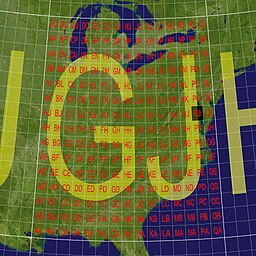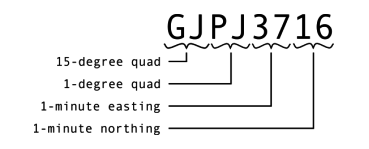|
World Geographic Reference System
The World Geographic Reference System (GEOREF) is a geocode, a grid-based method of specifying locations on the surface of the Earth. GEOREF is essentially based on the geographic system of latitude and longitude, but using a simpler and more flexible notation. GEOREF was used primarily in aeronautical charts for air navigation,[1] particularly in military or inter-service applications, but it is rarely seen today.[citation needed] However, GEOREF can be used with any map or chart that has latitude and longitude printed on it. QuadranglesGEOREF is based on the standard system of latitude and longitude, but uses a simpler and more concise notation. GEOREF divides the Earth's surface into successively smaller quadrangles, with a notation system used to identify each quadrangle within its parent. Unlike latitude/longitude, GEOREF runs in one direction horizontally, east from the 180° meridian; and one direction vertically, north from the South Pole. GEOREF can easily be adapted to give co-ordinates with varying degrees of precision, using a 2–12 character geocode. GEOREF co-ordinates are defined by successive divisions of the Earth's surface, as follows:
The initial two letters of a GEOREF reference, designating the 15 degree quadrangle, can be omitted, if it is clear which 15 degree quadrangle the reference applies to (e.g., when working within a restricted geographical area). Example For example, on a GEOREF chart, Naval Air Station Patuxent River (38°17′10″N 76°24′42″W) / (38.286108, -76.4291704) is located (to the nearest minute) at position GJPJ3417. To locate the position from the coordinates, proceed as follows:
The same co-ordinate shown in 6-digit (1/10 minute) format is GJPJ342171 and in 8-digit (1/100 minute) format is GJPJ34241716. Designation of areaExtensions to the above notation allow the GEOREF system to be used to designate an area around a reference point. This is achieved by adding an area designation to a base GEOREF co-ordinate. The area designation can be the letter S, to specify the sides of a rectangle (separated by the letter X); or the letter R, to specify the radius of a circle. In both cases the units are nautical miles. In addition, the letter H can be added, followed by an altitude in thousands of feet. For example, the reference GJQJ0207S6X8 designates a rectangle centered on Deal Island (GJQJ0207), running 6 nautical miles (11 km) east–west and 8 nautical miles (15 km) north–south. Designation GJPJ4103R5 means a circle around Point Lookout (GJPJ4103) with a radius of 5 nautical miles (9 km). Designation GJPJ3716H17 means a height of 17,000 feet over GJPJ3716. See also
References
|
